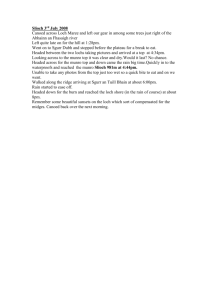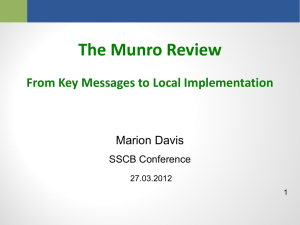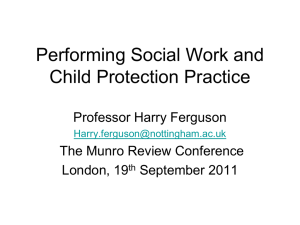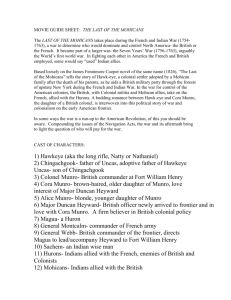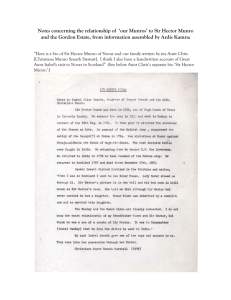newsletter 1 - Clan Munro (Association) Australia
advertisement
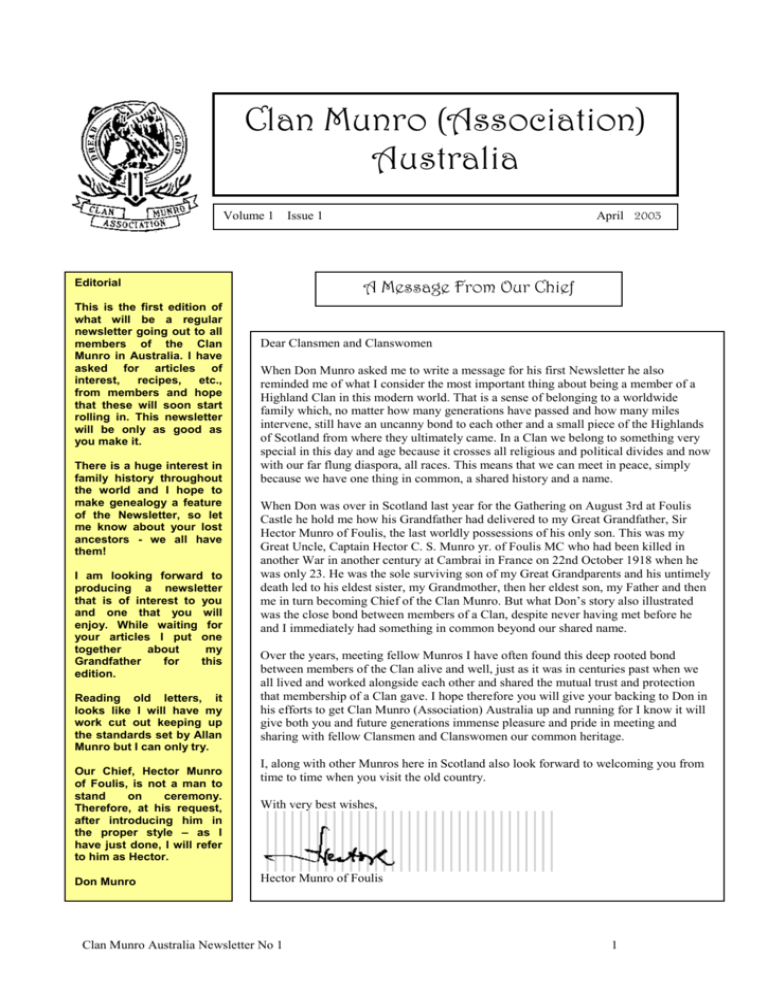
Clan Munro (Association) Australia Volume 1 A Message From Our Chief Editorial This is the first edition of what will be a regular newsletter going out to all members of the Clan Munro in Australia. I have asked for articles of interest, recipes, etc., from members and hope that these will soon start rolling in. This newsletter will be only as good as you make it. There is a huge interest in family history throughout the world and I hope to make genealogy a feature of the Newsletter, so let me know about your lost ancestors - we all have them! I am looking forward to producing a newsletter that is of interest to you and one that you will enjoy. While waiting for your articles I put one together about my Grandfather for this edition. Reading old letters, it looks like I will have my work cut out keeping up the standards set by Allan Munro but I can only try. Our Chief, Hector Munro of Foulis, is not a man to stand on ceremony. Therefore, at his request, after introducing him in the proper style – as I have just done, I will refer to him as Hector. Don Munro April 2003 Issue 1 Dear Clansmen and Clanswomen When Don Munro asked me to write a message for his first Newsletter he also reminded me of what I consider the most important thing about being a member of a Highland Clan in this modern world. That is a sense of belonging to a worldwide family which, no matter how many generations have passed and how many miles intervene, still have an uncanny bond to each other and a small piece of the Highlands of Scotland from where they ultimately came. In a Clan we belong to something very special in this day and age because it crosses all religious and political divides and now with our far flung diaspora, all races. This means that we can meet in peace, simply because we have one thing in common, a shared history and a name. When Don was over in Scotland last year for the Gathering on August 3rd at Foulis Castle he hold me how his Grandfather had delivered to my Great Grandfather, Sir Hector Munro of Foulis, the last worldly possessions of his only son. This was my Great Uncle, Captain Hector C. S. Munro yr. of Foulis MC who had been killed in another War in another century at Cambrai in France on 22nd October 1918 when he was only 23. He was the sole surviving son of my Great Grandparents and his untimely death led to his eldest sister, my Grandmother, then her eldest son, my Father and then me in turn becoming Chief of the Clan Munro. But what Don’s story also illustrated was the close bond between members of a Clan, despite never having met before he and I immediately had something in common beyond our shared name. Over the years, meeting fellow Munros I have often found this deep rooted bond between members of the Clan alive and well, just as it was in centuries past when we all lived and worked alongside each other and shared the mutual trust and protection that membership of a Clan gave. I hope therefore you will give your backing to Don in his efforts to get Clan Munro (Association) Australia up and running for I know it will give both you and future generations immense pleasure and pride in meeting and sharing with fellow Clansmen and Clanswomen our common heritage. I, along with other Munros here in Scotland also look forward to welcoming you from time to time when you visit the old country. With very best wishes, Hector Munro of Foulis Clan Munro Australia Newsletter No 1 1 Major Clan (As Donald Munro MC Seaforth Highlanders This is a brief history of my Grandfather, Major Donald Munro who was born in 1879/1880 and died in 1932. Donald Munro was born in Roskeen in Ross-shire as were his father and Grandfather before him and probably further back than that but I cannot go back further than his Grandfather. He was of humble stock; his Grandfather was a farm labourer and his father a farm labourer/ stone mason depending on the record you are viewing. Early in his youth, Donald moved to Dingwall and worked for a time with the firm of Mr William Paterson, corn and coal merchant. On the 8th of February 1898 he joined the Seaforth Highlanders at Fort George and two days later was posted to the 2nd Battalion in Dover – he did not get much chance to change his mind! I can only presume that he received his basic training in Dover for from there he went with the 2nd Battalion to the South African War. We served throughout that campaign, was at Wittenbergen and took part in the guerrilla warfare in Transvaal and Cape Colony The Battalion left Durban on the 20th January 1903 on the Lake Manitoba bound for Ireland. From a rough diary of his, I know that he was on Ireland in May and August 1903 and there is mention of Dublin and Neane Barracks, Curragh. He was in Edinburgh Castle in 1909 when his son, Donald (my father) was born. He served through WW1 and here are a few of the entries to show the horror of what he and the other soldiers went through and also to show the lighter side and the character of the man. How they got there. This is the first entry in the diary: 1914 Aug 23. Arrived Southampton 1 pm. Embarked XXXX (Cattle boat Johnstone line). Sailed at 9 pm The horror of war - less than a month later Sept 14 Marched all last night with the convoy: survived a circle of shellfire, first to come through safe, though at present it looks blue; slightly quiet now. 10 am commenced again heavier than ever. News just came through that the Colonel was killed two hours ago. Can scarcely realise it but unfortunately it is true. 12 noon. Fearful fighting and we are helpless where we are with the convoy. The din of large guns, m. guns & rifle fire is terrific, although up to the present they are apparently holding out. Darkness setting in and the guns are quiet. The Colonel, Lieutenant Clan Munro Australia Newsletter No 1 Williamson and Lieutenant Murray of the Gordons & 7 men buried at 8.30. Three days later: Sept 17 We are still holding the same position. Fighting only on left front. Convoy Park shelled considerably. H. artillery. Enemy’s battery of Long Toms bombarding convoy. 90 pounder shells dropping everywhere. We couldn’t get cover anywhere. Houses coming down and breaking into flames. I can’t describe the awful scene; men, horses and wagons smashed up and shells finding us always. 3 pm. After short lull the shells are dropping worse than ever and the scene is indescribable. A man came out of a house with awful wounds in head and legs and another man and I carried him away and dressed him. On the way back a shell struck a house about a yard from me and one of the falling stones knocked me down. My arm and shoulder seemed dead and I was stunned for the moment. Those who witnessed it reported me blown to pieces. Houses falling everywhere and breaking into flames. I’m wondering how we lived through it. After the firing ceased, I saw sights which I hope to God I shall never see again. In one shed I saw six men absolutely smashed to pieces, heads, arms and legs in one awful heap. I helped to get their identity disks from the bodies and seem to have lost all feeling. The village is now one mass of ruins and flames, with wounded and dead being carried to temporary hospital. 6 pm. All quiet and I can scarcely believe that I’m alive. Considering the awful shellfire, the casualties are very few. His Commission: Oct 5 9am. Just finished breakfast and orderly came to tell me that I had been granted a commission. Wonder what the new life will be like. Found Officers very nice and all were very kind and helped to fix up kit. Marched to Hartennes. Being Quartermaster did not mean that he was out of the firing line: Oct 13 Drove enemy from position at Fletre. Casualties in Battalion 90 k&w. Bayonet charge – led Platoon in action for first time. Oct 20 General attack on enemy’s lines. Battalion cleared them out with the bayonet. Very gallant stand by the Germans. Captain Methven killed. In the trenches: Oct 26 Enemy have brought up a mortar and started shelling us. I’ve cleared us out. My house blown to pieces. Whole Battalion took up new position. “C” Company in ditch, up to knees in mud from 9 am to 6.30 pm. Worst predicament I have ever been in Oct 29 Still raining and the place is a proper mud hole. Mackie of No 1 section killed by a sniper. No night attack. Scottish understatement: Nov 24 Quiet night but very cold and had small showers of rain. Nothing unusual – my hut burnt down. News of birth of Baby. (That would be my Auntie Aisne – named after the battle of the same name) St Andrews Night: Nov 30 What a change from St A. of last year. Makes on wish to be home with their dear ones. Hepburn killed. A lighter side: Dec 5 Had our St A dinner in billet last night. Pipers McLean & McMillan played during dinner. Made one forget for the moment that we are only a few miles from the firing line. Dec 6 Back in our old billet at farm. Mr Yeomans held service in barn and I enjoyed it very much. Had a shoot after service. Bag – 1 hare, 3 rabbits and 2 pheasants. The diary finished on Dec 15, only 4 months after it started and what a huge amount happened in that time. Grandfather would surely have kept diaries if the rest of the war and I would dearly like to read them but this one is, to my knowledge, the only one to survive. Without a doubt, his saddest moment of the war was having to take the body of Captain Charles Seymour Munro MC, from the battlefield just before the end of the war. Captain Munro was, of course, the son of the then Munro Chief, Sir Hector Munro of Foulis. Grandfather brought Captain Munro’s belongings home to Sir Hector and was given a cigarette case by him in gratitude. That cigarette case has a place of honour in my home along with Grandfather’s spurs, sgean dubh, medals and bonnet. A bonnet, not that one, figures in a postscript at the end of this article. For his services Major Donald Munro was awarded the Military Cross, the 1914 Star, the British War Medal and the Victory Medal After the war he was posted to India and he was posted from Meerut, India to the Depot (presumably Fort George) in December 1921. He died of pneumonia on the 8th of January 1932 in his 53rd year. It is that sad that he had served through the Boer War, WW1, Ireland and India only to die at such a young age of a non- 2 military cause. One of my greatest regrets is that I did not know him for he died before I was born. In fact my maternal Grandfather Johnstone died within a month of Grandfather Munro, so I did not get to know either of them. village of Limeaux in Northern France during its retreat from the Somme. With the enemy very close, Captain Patrick Munro of Foulis, their Company commander had the badly mauled remnants of ‘B’ Company (which included their only surviving officer, his youngest brother Hector Gascoigne) attached to his Company. Having just lost his driver, Captain Munro put his brother Hector in charge of his truck with orders to withdraw by road whilst he himself led the Company across country. The withdrawal took place without incident and they reached the village of Ramburelles at about 5 a.m. but Hector failed to arrive. Just as they set off to search for him he turned up on foot with a long face and explained that try as he Postscript to the above. At the Clan Gathering, I mentioned to Hector that my Grandfather had brought Captain Munro’s belongings back home to Sir Hector and he sent me the following extract from his father’s diary to me. “On June 5th 1940 ‘C’ Company, the 4th Battalion The Seaforth Highlanders part of the 51st Highland Division reached the might he couldn’t get the truck to start. He knew the Germans were very close and having his own equipment to carry he had no alternative but to abandon everything else in the truck, little realising that it contained all his elder brother possessed except for the clothes he stood up in. One of Captain Munro’s greatest losses was his late Uncle *Hector’s badge in his Glengarry bonnet, which had been all through WW1.” (*Captain Hector C. S. Munro yr. of Foulis MC was killed near Cambrai, N. France on 22 October 1918 aged 23 years. Coincidentally his nephew Hector Gascoigne was exactly the same age in June 1940). MY HOMELAND This poem has done the full circle and I am sure that it expresses the feelings of most, if not all of us. It has been taken from an Inverness Church magazine and is by a gentleman originally from Inverness but at his death, lived in Perth WA. His daughter read the poem when his ashes were interred in Tomnahurich Cemetery in Inverness. It is obviously written from the heart. I can’t forget my childhood The winding roads and hills blooming of the heather I could never get my fill. The silver of the The moonlight As it shimmers on the loch You may think I was an Aussie But deep down was always a Scot I’ve been in many places in this world And found it was not so wide I was never really lonely My accent I could not hide. The chanting of the bagpipes They filled my heart with pride And as the kilted bands went by My tears I could not hide. I like the land I lived in To my children it’s called home. But I hope they’ll see the Northern Lights And through the heather roam And see the Scottish castles Of which I was so proud No, I never could forget my homeland ‘Till they dress me in a shroud. Can You Help? This is our first genealogy segment. It would be great if any of our members could help find these lost relatives. I’m from the USA and I’m seeking some relatives who migrated to the Melbourne area in the 1890's or earlier (or rather their descendants). Their names were Daniel Munro born 1845 Glasgow, Scotland and James Munro born 1848 Dalry, Scotland. Their father was Daniel Munro a provisions merchant in Dalry and their mother was Jean Robb. They would've come to Melbourne and maybe have gone to Sydney, with their nephews William Crawford and Daniel Munro Crawford from the United States. (They went to Melbourne with their sister’s 2 sons.) Anyway out of the 4 men that went I’m sure that someone has descendants. They were last heard from in the early 1930s and then we had no more communication from Australia. Any help would be welcome. Janet Schnabel lazyjranch75428@yahoo.com - if you know any of these people contact Janet via her email address and copy it to me, otherwise drop me a note and I will pass the information on. (Don Munro) These next four are from our own genealogist, Ron Munro. Contact him by E-mail at oceaniamunros@iprimus.com.au or by post at PO Box 322, Salisbury, SA 5108 1. Thomas MUNRO married to Mary nee Mossisin, settled in the Goulburn District, NSW. A dau. Isabella mar. to Lancelot SHAW? Where did they come from where were they married? 2. Descendants of George MUNRO, parents George MUNRO (MONROE?) and Margaret (nee McFarlane) of Glamis and Forfar. Enquirer is a descendant of David MUNRO, a sibling of George. 4. These are two of Ron’s own elusive Munros. David Alexander Stevenson MUNRO (b. 1857) and his brother Thomas Murray MUNRO (b. 1863) both born in Coldingham, Berwick, Scotland. These tricky well hidden two are siblings to Ron’s Robert Stevenson MUNRO, marine engineer of steam ships, also born in Coldingham, 1859; and came out to South Australia c1890's. Robert is Ron’s great grand father. Clan Munro Australia Newsletter No 1 If you need any help with your research in Scotland contact Mr Norman Thompson. Norman is a professional genealogist Norman Thompson, M.A. (Hons), Dip.Ed., C.F.S.H.S. 31 Beechtree Place, Auchterarder, Perthshire PH3 1JQ Tel/Fax: 01764 664998 email norman@scots-heritage.co.uk Homepage - www.scots-heritage.co.uk/ Family history, Historical research in New Register House, National Archives of Scotland, and in regional archives throughout Scotland. Transcriptions. All types of records researched. 3 Panic Buying in Scotland! This item is from “Scottish Snippets.” To get a free copy direct from Scotland, just send an email to Scottie@RampantScotland.com with "Subscribe" in the subject line. Remember how as kids we used to hover round the kitchen table as Mum got the ingredients ready to make the tablet? Being allowed to scrape the condensed milk tin was just about the nearest thing to heaven that we kids could imagine. That tin finished cleaner and shinier than any new fangled dishwasher could get it! So it is easy to imagine the effect of the following announcement. An announcement that Nestlé, the world's largest manufacturer of condensed milk, was to stop production in the UK led to panic buying in supermarkets. Media reports had suggested that the announcement meant that it would no longer be available in the UK. Condensed milk is the basic ingredient of "tablet," a sugary confection, which is particularly popular in Scotland. It is as popular in Scotland as Mars bars and is often sold in tourist shops, in various flavours, as well as supermarkets. But as manufacturers of tablet voiced their concerns at the "disaster", Nestlé assured them that although UK production would cease, the product would still be available imported from France. Just in case you have lost your recipe for “Tablet” here is a reminder. Ingredients (for 4 pounds/1.8kg tablet): Butter or margarine - half pound (225g) Sweetened condensed milk - one tin Castor sugar - 4 pounds (1.8kg) Water - 1 pint (half litre) You can add some flavouring from essence/extract as well, if you wish Method Using a non-stick pan, put the water on a low heat and melt in the butter. Add the sugar and bring to the boil. It is important to keep stirring all the time. Once it is boiling, stir in the condensed milk and simmer for 20 minutes. Again, keep stirring to avoid it sticking/burning. Take off the heat and beat vigorously for five minutes, adding the flavouring of your choice. Pour into a rectangular greased tin and once it is partly cooled, cut and once the tablet is cold, store in an airtight jar or tin. Amazing Find This item is from the Scotsman and I thought it relevant to our main article. You can find this article on line at http://www.thescotsman.co.uk/scotland.cfm?id=248002003 Historic bagpipes found © JOHN STAPLES A set of bagpipes, which belonged to a fallen First World War soldier, has been found almost 90 years after his death. Scots piper James Richardson was awarded the VC for lifting the spirits of fellow troops under heavy fire at the Somme in 1916. However, after helping rescue wounded colleagues, the 17-year-old returned to pick up his pipes and disappeared in a hail of gunfire. It was thought neither his body, nor the pipes, would ever be recovered. But now the set has been found in a glass display case in Ardvreck School in Crieff, Perthshire. It has emerged that, months after Richardson’s death, a Major Edward Bate found the mud-caked broken pipes and kept them when he returned home to serve out a teaching post at the school. In 1931, he retired and bequeathed them to the institution. Roger McGuire, a Canadian historian and pipe major, spotted a plea for information from the school about the pipes on the Internet and flew to Scotland to investigate. He has now confirmed their authenticity. Clan Munro Australia Newsletter No 1 The material of the bag is badly mud-stained and brown flecks on the ivory pipes appear to be dried blood. But inside the bag the Lennox tartan, which was unique on the battlefield to Richardson, is still pristine. When records and old photographs of Richardson’s pipes were checked it was verified that he would have been the only piper in battle using the tartan. Mr McGuire said of the discovery: "When I saw them I felt the hair on the back of my neck was standing up. "The mud was still on them, and holding the pieces my imagination ran wild as to what they had actually experienced." Amateur historian Duncan Brown, 48, who has helped raise the profile of the 14 Lanarkshire VC winners, described the discovery as "staggering". MUNRO REUNION Have squeezed this in as I have just received it from E Ross Munro of Canterbury. A reunion is planned for descendants of Donald & Catherine (nee MacGillivray) Munro who arrived in Australia on Aug 3, 1853 with five children (they eventually had 12). They left Scotland on the Hercules on Dec 26, 1853 but disease on board kept them quarantined in Ireland for many months. Contact Lily Sims, Judge Book Retirement Village, Eltham, 3059 4 Munro Pioneers – Alexander Munro I searched the Internet for Australian Pioneers with the name of Munro and came across Alexander Munro who well and truly falls into this category Alexander Munro, from Ardersier in Inverness-shire, Scotland, was one of the pioneers of the Hunter Valley wine industry. In the mid 1800’s, he established the ‘Bebeah’ vineyard on the outskirts of Singleton, NSW. At one stage Munro was the largest wine producer in New South Wales claiming to hold 125,000 gallons of mature wine in stock. He is also reported to have won over 2000 Trophies, medals and awards including 511 champion and first prizes. finished writing this item when I asked Garth if he knew where Alexander came from and to my amazement, he replied “Ardersier near Inverness.” My Maternal Great Grandfather Johnstone would have been a fisherman in Ardersier at the same time as these Munros were there! The Eather Family now owns the Meerea Park Winery. My contact there is Garth Eather and together with his brother, Rhys, they run the winery with the help of their father and mother, Ian & Betty. Alexander Munro is Garth & Rhys’ Great, Great Grandfather. To put it in another way, Ian’s mother was Alexander’s eldest Grand Daughter. Rhys, as winemaker, has carried on the tradition of excellence and has won many medals for his wines in the years since he has held that position. There are three current release Alexander Munro wines. 1999 Alexander Munro Shiraz $45.00 per bottle (Gold medal) 2000 Alexander Munro Chardonnay $25.00 per bottle (Gold medal + Trophy) 1998 Alexander Munro Semillon $25.00 per bottle (Silver medal) Garth has very generously offered a 10% discount to Clan Munro members on the above prices and they will supply mixed dozens. To that you would have to add freight to the capital cities - Perth $18.00 per case, Sydney $8.00, Melbourne $12.00, Brisbane $12.00, Hobart $25.00, Adelaide $15.00, ACT $12.00. Tradition is obviously an integral part of the life and business of the Eathers and they are extremely proud of their heritage. Take their label for instance. When Alexander Munro retired as the first mayor of Singleton, he presented the town with a fountain that was made in Glasgow – that fountain appears in the label of the Meerea Park wines. Alexander was elected mayor in 1866. Alexander Munro’s name is saved for the best and is used on their reserve wines in which Shiraz, Semillon and Chardonnay are produced in years which reflect the ‘reserve wine’ status. Another selection is called “The Aunts” - so called in memory of three Eather sisters who lived on the Meerea Property around 1830. They even have a Forefathers Chardonnay. So there you have it, the brief story of a Munro Pioneer whose traditions and standard of excellence have been carried down to the present day. Do you know what is creepy about all of that? I had just If the Alexander Munro wines appeal to you, the following will be of interest you. Of course, if you are lucky enough to live nearby, why don’t you have a day out and drive to the Hunter Valley and collect your own. Just tell them Garth sent you. Here are the addresses. Winery Address: Lot 3 Palmers Lane POKOLBIN, NSW 2320 Tasting & Sales: The Boutique Wine Centre Broke Road, POKOLBIN, NSW 2320 Garth can be contacted by email on info@meereapark.com.au Rhys can be contacted by email on rhys@meereapark.com.au Web site http://www.meereapark.com.au/winery.html Clan Munro Magazine I have recently posted out the Clan Munro Magazine. If any of you did not receive it, please let me know and I will send one by return post. Australian Newsletter Levy As I said in my earlier letter, to cover Newsletter & postage costs, I am asking existing Life Members and Annual Members who have paid fees in advance for an annual levy of $5.00. If it is more convenient, you can pay in advance for as many years as you feel comfortable. My last letter may have caused some confusion, so please note that Life Members are not being asked to renew their membership. Cheques, etc., should be made payable to the Clan Munro (Association). Annual fees now due should be sent to me and don’t worry if you have dropped out for a few years; you are welcome back as from this year. Your new fees include the $5.00 Newsletter & postage cost. I know that many of you have already paid the annual subs & levy, so the above obviously does not apply to you Clan Munro Australia Newsletter No 1 5 Earth Wind Fire The other day Bet was looking at a newspaper cutting from an Inverness Courier that had been sent out to her a couple of years ago. On turning the cutting over a familiar, pretty face looked back at her from a photo of a group of musicians. It was none other than Sarah “Alpha” Munro, the wife of our chief, so I thought the following would be of interest The article was all about encouraging the musical skills of the young people in the North of Scotland and this is the part of particular interest to us. “Leading lights of the Highland traditional music scene have lent their talents to ‘Earth Wind Fire,’ the debut recording by the Kiltearn Fiddlers, pupils of Sarah “Alpha” Munro. The group had its origins in three pupils who took part in a weekly fiddle class that started in 1990 with Alpha as teacher. The class has now grown to 40 and many of the older players entertain in care homes and at local ceilidhs and festivals. The group has also appeared on radio and TV but many of Alpha’s students aged 8 and upwards, had never played into a microphone before the recording was made.” It would seem that the Kiltearn Fiddlers are very special in the Highland music scene and it is all due to Alpha’s inspirational lead. All of the local community support her and it is this type of dedication that will have an effect on Scottish music for years to come. Alpha is a very talented lady and we hope to hear more about her in later editions of the Newsletter. The Storehouse of Foulis has the following copies of Alpha’s CDs – Stars in the Wave - £12.99 & Earth Wind Fire £10.00. Postage for one is £1.90 or £2.90 for both. The Stars in the Wave music book by Alpha is also available at a cost of £6.00, postage £2.90. The address is Storehouse of Foulis, Foulis Ferry, Evanton, Ross-shire, Scotland, IV16 9UX – their email address is admin@storehouseoffoulis.co.uk and their website is http://www.storehouseoffoulis.co.uk/ Do We Continue? The big question for you to decide now is whether or not our Newsletter continues. From the letter I sent out with the Clan Munro Magazine, I have had quite a few responses mostly by email and all positive. It is encouraging that levy payments have started to trickle in – one member generously donated $50.00 so he is covered for the next ten years! Annual subs have also started to come in and we have four new members to date. Costs for this issue are just about covered. I have committed myself to at least this year ie another two issues. I have started collecting items for the next Newsletter, so send yours in – there must be a wealth of untapped and interesting material out there just waiting to see the light of day. Could any member who was at the Clan Gathering last year please send me a report on their impressions of the Gathering as I would like to include a couple of reports in the next Newsletter. One member has already volunteered to do this and if there are others, that would be great. Clan Munro (Association) Australia Newsletter Sender Don Munro 18 Salter Road Mt Nasura WA 6112 Clan Munro Australia Newsletter No 1 6
